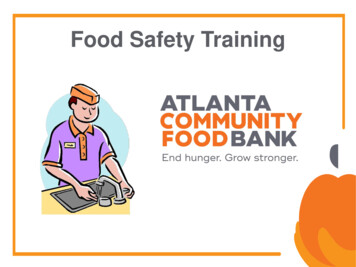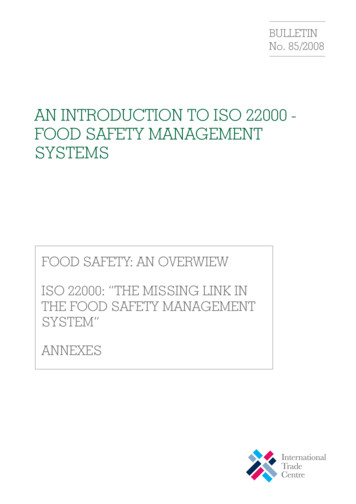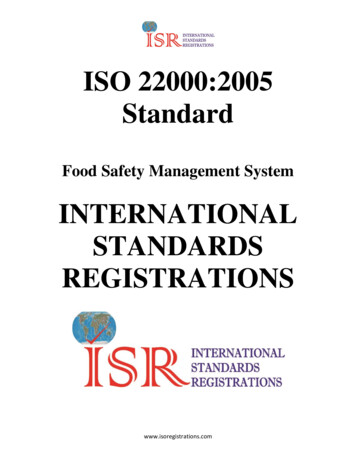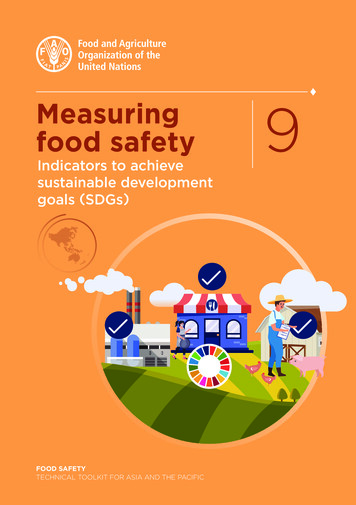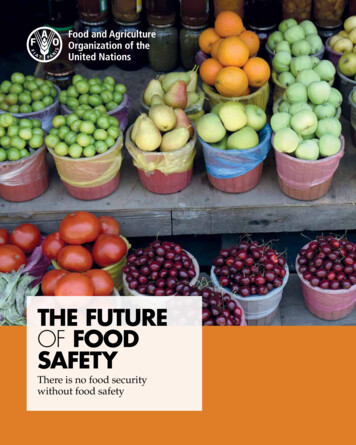
Transcription
THE FUTUREOF FOODSAFETYThere is no food securitywithout food safety
THE FUTURE OF FOOD SAFETYCONTENTSPAGES 4–5INTRODUCTIONPAGES 6–7KEY MESSAGESPAGES 8–13THERE IS NO FOODSECURITY WITHOUTFOOD SAFETYPAGES 14–17FOOD SAFETYIS SCIENCE-CENTREDIT ISPARAMOUNTTHAT WE FINDSUSTAINABLEWAYS TOCULTIVATE,PRODUCE ANDCONSUME SAFEAND HEALTHYFOODS WHILEPRESERVINGOUR PLANET’SNATURALRESOURCES.PAGES 18–21FOOD SAFETY REQUIRESSHARED SOLUTIONSPAGES 22–25FOOD SAFETYIN EMERGENCIESPAGES 26–27PUBLICATIONSCover photo: Azerbaijan – Vandam village, fresh fruit is displayed at aroadside produce stand. FAO/Tofik Babayev2
GUATEMALAFruit and vegetables stall at thegreen market. Pep Bonet/NOOR for FAO3
THE FUTURE OF FOOD SAFETYINTRODUCTIONToday’s globalchallenges aretransforming the waywe produce, market,consume and thinkabout food.EVERY YEARAROUNDTHE WORLD,OVER 420 000PEOPLE DIEAND SOME600 MILLIONPEOPLE FALL ILLAFTER EATINGCONTAMINATEDFOODReady access to safe and nutritiousfood is a basic human right.Yet every year around the world,over 420 000 people die andsome 600 million people – almostone in ten – fall ill after eatingcontaminated food. In fact,foodborne hazards are known tocause over 200 acute and chronicdiseases from digestive tractinfections to cancer.The ramifications of the costof unsafe food, however, gofar beyond human suffering.Contaminated food hamperssocioeconomic development,overloads healthcare systems andcompromises economic growthand trade. Opportunities of anincreasingly-globalized foodmarket are lost to countries unableto meet international food safetystandards. Food safety threatscause an enormous burden on4ITALYAssociations farmers,producing in Lazio regionsurrounding Rome, gatherin weekly markets to sellfood products from theshort distribution chain. FAO/Riccardo De Lucaeconomies from disruptions orrestrictions in global and regionalagri-food trade, loss of food andassociated income and wastednatural resources.Today’s global challenges aretransforming the way we produce,market, consume and thinkabout food. The most pressing ofthese revolve around a growingpopulation and increased fooddemands, further compoundedby the adverse impacts of
environmental degradation,climate change, water scarcity,loss of biodiversity, conflictand socio-economic inequities.Hunger is on the rise andpreventable foodborne diseasescontinue to affect millions ofpeople annually. Food safety issueshinder global food security andour collective goal of achievingthe Sustainable DevelopmentGoals by 2030, and exacerbate thepoverty cycle affecting the mostvulnerable populations.Our cities are changing,transforming our food systems.With rapid urbanization, citiesneed to keep food safety andsustainable food systems planninghigh on their agenda. Today, halfthe world’s population live in citiesor towns on only three percentof the Earth’s surface. By 2050,over 65 percent of all people willbe urban dwellers. This meansthat issues related to food safety,food production and distributionwill take on even greater5importance in strategic discussionson sustainable developmentand growth.No matter how much ourworld continues to evolve andchallenge us, the greatest riskwould be our failure to protectand safeguard our food systems.It is paramount that we findsustainable ways to cultivate,produce and consume safe andhealthy foods while preservingour planet’s natural resources.
THE FUTURE OF FOOD SAFETYKEYMESSAGESFood safety is integralto the SustainableDevelopment Goals.When food is not safe, humandevelopment simply cannot takeplace. In its plan of action forpeople, planet and prosperity,the 2030 Agenda calls foreveryone, in particular thepoor and the vulnerable, tohave access to safe, nutritiousand sufficient food all yearround. It pledges to ensurehealthy lives and promotewell-being, which are essentialto sustainable development.Unsafe food takes ahuge toll on humanhealth and the economy.Every year more than600 million people fall illand 420 000 die from eatingfood contaminated withbacteria, viruses, parasites,toxins or chemicals.Unsafe food accounted for33 million disability-adjustedlife years in 2010. As for theeconomic price tag, unsafefood costs low- andmiddle-income economies aloneabout US 95 billion in lostproductivity annually and cancurtail trade.NIGERA fruit vendor at theMaradi market. FAO/Giulio NapolitanoAgriculture is underpressure, and foodproduction is changing,with consequences forfood safety.In a world of acceleratingchange, the need for food to besafe remains a constant. As theworld is facing an unprecedentedconvergence of pressures fromsocio-economic, environmentaland political fronts, a shift towardssustainable agricultural practicesacross all sectors and the wholesupply chain is required to ensurea viable, sufficient and nutritioussupply of safe food. Such a changemust minimize environmentalimpacts, mitigate climate change,and promote economic growth andsocial equity.From production toconsumption – foodsafety is a sharedresponsibility.Food safety is everyone’sresponsibility. Today, food is6produced and processed ingreater volumes and distributedover greater distances than everbefore. Widespread collaborationand contributions of all actorsacross the food supply chain,underpinned by robust governance,agreed international standardsand harmonized regulations, areessential to food safety.Good nutrition requiressafe food.Unsafe food prevents thesuitable uptake of nutrientsand renders it unsuitable forhuman consumption and canlead to long-term growth and
THERE IS NOFOOD SECURITYWITHOUT FOODSAFETY, WHICH ISTHE BASE FORHEALTHY DIETSAND LIVESJosé Graziano da SilvaFAO Director-Generaldevelopmental delays in children.Poor nutrition makes peoplemore susceptible to diseases.It is a vicious cycle that must bebroken. Sustainable DevelopmentGoal 2, which is about endinghunger, achieving food security,improving nutrition andpromoting sustainable agriculture,can only be achieved when food issafe for people to eat.Food standards help tosafeguard public health at large.Harmonized international foodstandards ensure that food issafe, healthy and of good quality,and can be safely traded betweencountries or passed on along a foodvalue chain, enabling all playersto comply with requirementselsewhere. International standardsshield countries and companiesfrom discretionary nationaltrade barriers.We need to keep pace with therapidly changing food systems.Production and processingmethods and technologiescontinue to transform trade,changing the way food movesfrom farm to fork. It is essential toensure that the many economic,social and environmental factorsdriving these changes contributeto our ability to achieve ZeroHunger for a global populationthat is projected to reach almost10 billion by 2050.7
THE FUTURE OF FOOD SAFETYTHERE IS NOFOOD SECURITYWITHOUT FOODSAFETYIf it is not safe, it is not food. Food security isachieved when all people, at all times, havephysical and economic access to food that meetstheir dietary needs for an active and healthylife. Food safety plays a critical role across thefour pillars of food security – availability, access,utilization and stability.The increased globalization ofthe world’s food supply meanspopulations worldwide aremore exposed to food hazards.This is of particular concern forcountries that rely heavily onfood imports.Many developing countriesimport a significant share of thefood supply for their population.Some – such as the Pacificislands – rely almost entirelyon food imports to ensurefood security.Coordinated inspection andmonitoring programmes lieat the heart of enforcing foodsafety regulatory systemsto prevent or minimizeexposure to food hazards.Importing countries haveprogressively set up inspectionmeasures to protect the healthof their populations andensure fair practices in foodtrade. However, over time,higher volumes of importedfoods, together with thediversification of origin andgrowing complexity of thetechnologies used for traditionalmonitoring approaches, basedon intermittent or irregularinspections at borders, is nolonger considered adequate.A growing challenge forimported food is that competent8COOK ISLANDSFarmer startedplanting bananas forhis family to ensure hecan provide for theirfood needs. FAO/Sue Priceauthorities in charge of officialcontrols have no direct oversightover the production processof their trading partners.With the development of tradingrelationships, increased dialoguebetween competent authoritiesof importing and exportingcountries, use of certificationmechanisms and improvedoversight of the importerscommunity are some of theavailable options to strengthenthe effectiveness of importedfood controls.
Regardless of where food isproduced, consumers have the rightto expect that the food they buy issafe and of the expected quality.FAO works with governmentalauthorities, local industry and otherrelevant stakeholders to ensure thatthis expectation is met.SAFE FOOD ENHANCESLIVELIHOODS AND BOOSTSTRADE OPPORTUNITIESChemical residues andmicrobiological contaminationcontinue to pose publicSmall Island Developing States (SIDS) share unique and particularvulnerabilities, resulting in a complex set of food security and nutritionchallenges. Given their limited arable land, geographic isolationand exposure to extreme weather events, many SIDS rely heavily onremote markets for their food supplies, making them especially sensitiveto external shocks such as food price and supply volatility. As well,consuming a diet of processed imported foods that are high in sugar,salt and fats, many SIDS suffer from the “triple burden” of malnutrition,where undernutrition, micronutrient deficiencies, and obesity co-exist inthe population.A major challenge facing SIDS is to enhance their ability to deliver safe,high-quality and nutritious food at reasonable prices to consumers whilestimulating sustainable domestic food production and providing viablelivelihoods to those involved in production and transformative activities.Strategies to educate and raise awareness among the different actorsalong value chains about the importance of food safety (such as safestorage and handling techniques) are essential.health risks and lead to tradedisruptions with substantialeconomic and social costs.Opportunities of the globalfood market are lost tocountries that are unableto meet international foodsafety standards.9In addition, at the local level,farmers and producers who meetconsumers’ growing demandsfor more sustainably-producedfoods have the opportunity toimprove their livelihood andfoster economic development inrural communities.
THE FUTURE OF FOOD SAFETYTHERE IS NO FOODSECURITY WITHOUTFOOD SAFETYPROTECTING HEALTH,FACILITATING TRADEThere are significantinterlinkages between foodsafety and tradeExpansion in agricultural tradehas increased the availability andaffordability of food, but at thesame time it has increased thechances that unsafe or unhealthyfood produced in one countrycan affect consumer patterns inanother. The use of internationalfood standards worldwidecontributes to achieving globalpublic health objectives, as itcan ensure that the food thatgets traded is safe. In addition,it helps reduce trade costs byallowing food to move moresmoothly between markets.In this regard, it is crucial thatgovernments strategically investand actively engage in the workof international bodies such asthe Codex Alimentarius andTHERE IS NOFOOD SECURITYWITHOUTFOOD SAFETYCOSTA RICAFarmers workingin a pineappleplantation, applyinggood agriculturalpractices throughoutthe production process and packagingof pineapple. FAO/EzequielBecerrathe World Trade Organization(WTO) Committees on Sanitaryand Phytosanitary Measures(SPS Committee) and onTechnical Barriers to Trade (TBTCommittee), particularly in anera when scientific knowledge,technology, products andtrade are rapidly evolving andbecoming increasingly dynamicand diverse, making the10existence of strong institutionsan imperative.Why food safety and trade?The relationship between agri-foodtrade and food safety is attractingincreasing attention on boththe trade and the developmentagendas. Trade contributesto food availability and dietdiversification throughout the
world; however, it can alsoincrease the chances that the foodproduced in one place will affectthe health and diet of people livingelsewhere. Unilaterally-developednational food safety norms andspecifications often make it difficultfor food to be traded across borders.As such, global food safety andnutrition measures applicableacross borders, institutionsand disciplines, including theestablishment of evidence-basedinternational standards on foodsafety and nutrition, have becomemore important than ever before.As highlighted in Trade andFood Standards,1 a joint FAO/WTO publication, in order totrade internationally and haveaccess to markets for high-value11products, producers must beable to meet national foodregulations. Complying with theserequirements in export markets – ina fragmented system of conflictingnational food safety standards –can be challenging, especially forsmaller producers in developingcountries and emerging economies.1www.fao.org/3/a-i7407e.pdf
THE FUTURE OF FOOD SAFETYTHERE IS NO FOODSECURITY WITHOUTFOOD SAFETYCODEX HASWORKED ONFOOD SAFETYAND TRADE FOROVER 50 YEARS.IT HELD ITS FIRSTMEETING IN1963 AND SINCETHEN CODEXHAS DEVELOPEDHUNDREDS OFINTERNATIONALLYRECOGNIZEDSTANDARDS,GUIDELINES ANDCODES OFPRACTICECodex AlimentariusFood protection standards haveexisted since ancient times.The Assyrians determined weightsand measurements for cereals, theEgyptians used scrolls as labels forcertain foods, the Greeks inspectedbeer and wine to ensure it was ingood condition, and the Romanshad a State system to prevent fraudand root out poor-quality products.Today, protecting the health ofconsumers ranges from inspectingfood additives and pesticideresidues to preventing chemicaland microbiological contaminationor assessing the safety of modern,at times controversial, practicessuch as genetically modifyingfoods or using growth-promotingantimicrobials in animalproduction. While times havechanged, the goal to protectconsumers remains the same.The Codex AlimentariusCommission held its first meetingin 1963 with the objective ofdeveloping food standards toprotect public health and ensurefair practices in food trade.Since then, it has developedhundreds of internationallyrecognized standards, guidelinesand codes of practice, and playsa crucial role in ensuring thattraded food is safe and of highquality. This role is also recognizedby the WTO Agreements onthe Application of Sanitary and12SWAZILANDRed cabbage growingin an orchard fieldwhich is sold at awholesale marketthat was establishedto facilitate access tomarket opportunitiesfor smallholderproducers and linkthem with buyers. FAO/BelieveNyakudjaraPhytosanitary Measures (SPSAgreement) and on TechnicalBarriers to Trade (TBT Agreement).The Joint FAO/WHO FoodStandards Programme includes theCodex Alimentarius Commission,which is an inter-governmentalfood standard-setting body.Its standards, published as theCodex Alimentarius, serveas a “food code” that covers
the entire production chain.These science-based, internationallyadopted standards provide aframework for governments toestablish criteria for food to ensuresafety and harmonize food trade.Codex is, therefore, the invisiblelink between those working inthe food chain and the consumer.The Codex Alimentarius is vital forgovernments, industries and otheractors in helping to ensure thatfood is safe to eat regardless of theborders that it has crossed.INVESTING IN SUSTAINABLE FOODSYSTEMS PAYS OFFSustainable food systems are thefuture of food and agriculture.FAO supports governmentalauthorities, local industry andall those in supply chains toensure that the food availableon domestic and international13markets is safe and of the expectedquality. Each year, unsafe foodcauses production losses ofaround USD 95 billion in lowand middle-income economies.Safe food production improvessustainability by reducing foodwaste and by enabling marketaccess and productivity, whichdrives economic development andpoverty alleviation, especially inrural areas.
THE FUTURE OF FOOD SAFETYFOOD SAFETY s public healthand protects trade.Risk assessmentprovides policymakers with theinformation andevidence they needfor effective andtransparent decisionmaking, contributingto better food safetyoutcomes andimprovements inpublic health. FAO andWHO expert scientificbodies provide themost robust andup-to-date scientificadvice available.STRATEGY AND SCIENCE:FAO’S FOOD SAFETY APPROACHFAO works closely with itsMembers and internationalfood safety experts to provideguidance for developing andemerging countries so that “thebest available evidence” is usedto inform food safety decisions.This guidance is tailored tospecific country needs, especiallythose that may be data-poor orhave less mature control systemsand are keen to promote highlyparticipative approaches tofoster ownership of the processand results. The availability ofagreed decision-making toolsfacilitates an inclusive andtransparent process for foodsafety decisions, based on abroad set of factors rather than asingle consideration.Making sound strategic decisionsis the primary responsibility offood safety risk managers, whomust weigh multiple criteriaand sometimes complex riskinteractions. Decisions oftenrequire balancing food safetypriorities with resources, followingmultiple policy recommendationsand selecting the most appropriateintervention to minimize risks.To be effective in building strongfood safety programmes, foodsafety risk managers need toinfluence high-level decisions14ZIMBABWEStrengthening controlsof food safety threats,plant and animalpests and diseases foragriculturalproductivity and tradein Southern Africa. FAO/JekesaiNjikizanabased on best available dataand evidence to prioritize foodsafety in their countries. Also indetermining appropriate action,decision-makers often need toconsider the consequences relatingto more than one risk factor, forexample, the multiple impacts onpublic health, trade, food accessand security.Science is central to the workof FAO on food safety and
quality along the supply chain.In close collaboration withWHO, FAO provides neutraland independent scientificadvice as the essential basis forthe international food safetystandards, guidelines andcodes of practice establishedby the Codex AlimentariusCommission, and for supportingthe development of modernfood control systems bynational authorities such aswhole genome sequencing forepidemiological surveillancefor foodborne pathogens.In developing high qualityglobally relevant scientificadvice, consideration is givento the entire food productionchain as appropriate as well asall relevant and accessible data.Regular updates are made to themethods and approaches used toensure consistency with the mostrecent developments.15SAFE FOOD ISUNDERPINNEDBY SCIENCE
THE FUTURE OF FOOD SAFETYFOOD SAFETY ISSCIENCE-CENTREDThe Joint FAO/WHO ExpertCommittee on Food Additives(JECFA) has been meeting since1956 to provide scientific adviceon food additives, contaminantsand residues of veterinary drugsin food as well as principles andguidance for safety assessment ofchemicals in food.SCIENCE ISCENTRAL TO THEWORK OF FAOON FOOD SAFETYAND QUALITYALONG THESUPPLY CHAINThe Joint FAO/WHO ExpertMeetings on MicrobiologicalRisk Assessment (JEMRA)began in 2000 as an internationalscientific expert group thatevaluates different aspects ofmicrobiological hazards in thefood supply.The Joint Meeting onPesticide Residues (JMPR)is an expert ad hoc bodyadministered jointly by FAOand WHO to harmonizethe requirements and riskassessment for pesticideresidues. The JMPR has metannually since 1963 to conductscientific evaluations of pesticideresidues in food, providingadvice on the acceptable levelsof pesticide residues in foodtraded internationally.The Joint FAO/WHO ExpertMeetings on Nutrition(JEMNU) were established in2010 to strengthen the role ofFAO and WHO in providingscientific advice on nutritionto Member States and bodiessuch as the Codex AlimentariusCommission and in particular theCodex Committee for Nutritionand Foods for Special DietaryUses (CCNFSDU) with a view toset appropriate health-protectiveand trade-inclusive globalnutrition standards.16
SENEGALInspecting melonsusing a magnifier in acold room storage. FAO/Marco LongariCOREPRINCIPLESFOR SCIENTIFICADVICE Soundness:scientific excellence,evidence-based, rigorousand repeatable Responsibility:accountability, safeguardingthe integrity of the process Objectivity:includes neutrality of theexperts and of the adviceprovided Fairness:of the process, and respectfor all participants and theirscientific views Transparency:of both the process and thescientific advice Inclusiveness:balance of skills andexpertise, minority scientificopinion, geographical andsocioeconomic balancewithout compromisingexcellence17
THE FUTURE OF FOOD SAFETYFOOD SAFETY REQUIRESSHARED SOLUTIONSHuman health isclosely interlinkedwith the healthof animals andthe environmentaround usFOOD SAFETYIS PART OF“ONE HEALTH”Diseases know no borders. Theexpansion of global trade isleading to new health challengessuch as the wider spread ofmicroorganisms to people throughfood – from fruits and vegetablescontaminated with soil andfrom animal-sourced foods. Inresponse, FAO promotes a “OneHealth” approach as an integrated,multisectoral way to prevent andmitigate health threats across theanimal-human-plant-environmentinterface. To do so, the TripartitePartnership of FAO, the WorldHealth Organization (WHO) andthe World Organisation for AnimalHealth (OIE) work closely toencourage practices that decreasethe likelihood of live animalscarrying pathogens transmissibleto people and prevent thetransfer of contaminants from theenvironment to foods. The “OneHealth” approach brings togetherknowledge, insights and technicalcapacities in human and animalhealth and food and agriculturethat generate strong synergies, formore robust, effective and costefficient solutions to the complexhealth problems facing the worldtoday.FOOD SAFETY AND PRODUCE,LIVESTOCK AND FISHFAO combines expertise insustainable food productionacross the agricultural sectors and18food safety disciplines to identifysources of food safety risk andto develop measures to preventor minimize these risks at themost appropriate stages of thechain. Working with concernedstakeholders at national andlocal levels from both public andprivate sectors, FAO helps tostrengthen the management offood safety in specific sectors andformulates strategies that promotethe application of Good HygienicPractices and ensure compliancewith national and internationalfood safety requirements.Food safety and produceFAO food safety and plantproduction specialists workwith national institutions todevelop guidelines and codesof practice that integrate foodsafety considerations intosustainable agricultural practices.Long-term impact is ensuredthrough capacity buildingactivities with local, national andregional partners.Selected examples: Mycotoxin can affect staplefoods such as maize and sorghumand high value commoditiessuch as coffee and cocoa withimportant consequent foodsecurity implications for poorand vulnerable populations.These toxins are implicated in
MYANMARSupportingconflict-affectedcommunities innorthern Rakhine. FAO/Hkun Lata wide range of health effectsthat include liver and kidneydamage, among others. FAO andWHO produced a user-friendlyand freely-available online toolto guide national authoritiesand operators to sample26 mycotoxin-commoditycombinations. Farmer Field Schools (FFS)have proved to be an effectivevehicle for enabling farmersto understand and adhereto good practices. FFS aredeveloped to fully integrate foodhygiene with productionissues such as integrated pestmanagement techniques. FAO works with nationalinstitutions to build theircapacities to design and implementprogrammes to improve foodsafety in the primary production offruit and vegetables. This includesprogrammes focusing on goodpractices on farm as well ason monitoring pesticide andother contaminants.Food safety and livestockImproving the safety of foodsof animal origin involvesguidance on good practicesin animal feeding, animalhusbandry, slaughter andhandling and processing ofanimal products. FAO expertson animal production, animalhealth and food safety workclosely with partners to ensure19a science-based and integratedapproach to managing food safetyrisks related to foods of animalorigin, including antimicrobialresistance (AMR).Food producers play a vitalrole in stopping the spreadof antimicrobial resistance.Antimicrobial drugs are essentialto protect both human and animalhealth. However, antimicrobials,if misused for treatement orprevention of diseases in thelivestock, aquaculture or cropproduction sectors, can contributeto AMR – one of the world’s mostpressing public health threats.AMR reduces the effectiveness ofmedicines, making infections
THE FUTURE OF FOOD SAFETYFOOD SAFETY REQUIRESSHARED SOLUTIONSand diseases difficult or impossibleto treat in animals, plants andhumans alike. Each year, anestimated 700 000 people diedue to antimicrobial-resistantinfections, with the largest tollin low- and middle-incomecountries. Good hygiene practicesin agriculture, food production,processing and distributionare required to maintainfood safety and minimize thetransmission of AMR and otherpathogens through the foodchain to people. If antibioticsare not used appropriately,antimicrobial residues in foodcan also pose health hazards toconsumers. Promoting a “OneHealth” approach to combatingAMR, FAO, in partnership withWHO and OIE, encouragesfood production practices that:reduce the use of antimicrobials;enhance food hygiene andsanitation during processingto limit cross-contamination;and monitor progress inproducing food that is free fromantimicrobial-resistant pathogens.Food safety and fish andfishery productsImproving the quality andsafety of fish products requiresinterventions at various stages ofthe value chain. FAO, workingwith national authorities andother relevant stakeholders, assistsin developing the capacities forfish inspection and for promotingthe application of good practicesby all operators in fisheries andaquaculture: fishers, fish farmers,fish handlers and processors.FAO uses participatory approachesto assess training needs andto design and implementprogrammes for long-termcapacity building. For example,Scombrotoxin Fish Poisoning(SFP) often called “histaminepoisoning” occurs when certainspecies of marine fish – includingtuna, mackerel, sardines andanchovy – are stored improperly,as a naturally-occurring aminoacid of the fish is convertedto histamine by bacterialcontaminants. In some parts ofthe world, SFP is a major cause offoodborne illness.2WRITING THE RULES:NATIONAL LEGAL FRAMEWORKSModern food legislation is a keypillar for an effective food controlsystem. In all countries, food isgoverned by a complex set of lawsand regulations which set out thegovernment’s requirements tobe met by food chain operatorsto ensure the food is safe and ofadequate quality.2FAO has published suitable guidance to aidcountries in the management of such risks:www.fao.org/fileadmin/user upload/agns/news events/HistamineHighlightFINAL.pdf20FAO has a unique reservoir ofknowledge and information toassist countries in drafting oramending legislation relevantto food safety and quality.This invaluable resource andcollective wisdom has beenaccumulated over 40 years ofengagement with different legaltraditions around the world.FAO can assist in promotingthe design of workable andappropriate national regulatoryframeworks in all areas underFAO’s mandate, as well asprovide assistance through legaland institutional assessments;support to participatory legalreform processes; preparationof draft laws; and capacitydevelopment activities for lawyersand regulators. Such capacitydevelopment helps countriesto improve their abilitiesto autonomously formulateappropriate legislation.
EGYPTPromoting anddeveloping nationalpotential on effectivesustainablenon-conventionalwater use practices forintegrated agricultureaquacultureproduction systems. FAO/KhaledDesoukiAssistance is tailored to eachcountry’s situation, with attentionto the national legal frameworkand tradition, as well as to theimplementation of applicableinternational agreements andinternational reference standards.To date, FAO has assisted a broadrange of countries and regionalorganizations across five continentsin revising their legislation.FAO also has the world’s largestlegislative database (FAOLEX) onfood and agriculture, includingnatural resources management(fisheries, land, water andforestry), and provides legalinformation by publishinglegislative studies and legalpapers online, including goodregulatory practices (GRPs) fordrafting or revising national legalframeworks. These publicationscover different SPS-related topics,not only food safety, but alsoanimal and plant health andbiosafety. FAOLEX, establishedin 1995 is updated with anaverage of 8 000 new entries peryear. It currently contains legaland policy documents drawnfrom more than 200 countries,territories and regional economicintegration organizations andoriginating in over 40 languages.Governance enables safe andnutritious food for all.National governance is criticalfor ensuring that we can alleat safe and nutritious food.FAO is supporting governments intransitioning food control systemsinto governance mechanisms thatfoster sustainable agriculture, theproduction of safe and nutritiousfoods and access to fair globaltrade. An enabling governanceat national level also contributesto achieving the SustainableDevelopment Goals.21MODERN FOODLEGISLATION IS AKEY PILLAR FORAN EFFECTIVEFOOD CONTROLS
food safety is science-centred pages 18–21 food safety requires shared solutions pages 22–25 food safety in emergencies pages 26–27 publications it is paramount that we find sustainable ways to cultivate, produce and consume safe and healthy foods while preserving our planet’s n


